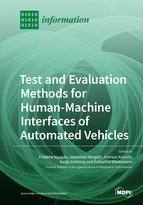Test and Evaluation Methods for Human-Machine Interfaces of Automated Vehicles
A special issue of Information (ISSN 2078-2489). This special issue belongs to the section "Information Applications".
Deadline for manuscript submissions: closed (31 May 2020) | Viewed by 93035
Special Issue Editors
Interests: usability; human–machine interaction; human factors; automated driving
Special Issues, Collections and Topics in MDPI journals
Interests: human-machine interaction; safety in use; distracted driving; usability; human factors; assisted and automated driving
Special Issues, Collections and Topics in MDPI journals
Interests: usability; human–machine interaction; human factors; automated driving
Special Issues, Collections and Topics in MDPI journals
Interests: usability; human–machine interaction; human factors; automated driving
Special Issues, Collections and Topics in MDPI journals
Interests: usability; human–machine interaction; human factors; automated driving
Special Issues, Collections and Topics in MDPI journals
Special Issue Information
Dear Colleagues,
Today, OEMs and suppliers can rely on commonly agreed and standardized testing and evaluating methods for in-vehicle human–machine interfaces (HMIs). These have traditionally focused on the context of manually driven vehicles and put the evaluation of minimizing distraction effects and enhancing usability at their core (e.g., AAM guidelines or NHTSA visual distraction guidelines).
However, advances in automated driving systems (ADS) have already begun to change the driver’s role from actively driving the vehicle to monitoring the driving situation and being ready to intervene in partially automated driving (SAE L2). Higher levels of vehicle automation will likely only require the driver to act as a fallback ready user in case of system limits and malfunctions (SAE L3) or could even act without any fallback within their operational design domain (SAE L4). During the same trip, different levels of automation might be available to the driver (e.g., L2 in urban environments, L3 on highways). These developments require new test and evaluation methods for ADS, as available test methods cannot be easily transferred and adapted.
For example, The ADS HMI should be capable of informing the user about the current mode and minimize confusion about the status of the ADS and the user’s current responsibilities (e.g., whether the ADS is functioning properly, ready for use, unavailable for use or requesting a transition of control from the ADS to the user). While ADS might allow new and more comfortable seating positions and engagement in nondriving-related tasks that were not allowed in manual driving, these might generate motion sickness or lower the user’s availability for a transfer of control. As the driving task is no longer actively fulfilled by the driver, distraction by nondriving-related tasks might turn into controlled engagement. ADS might behave differently than manually driven vehicles, which might generate a need for external HMIs or standardized motion patterns to adequately interact with non-equipped traffic participants.
This Special Issue welcomes theoretical papers as well as empirical studies that deal with these new challenges by proposing new and innovative test methods in the evaluation of ADS HMIs in areas such as (but not limited to) the topics below:
- Mode awareness and mode indicators;
- Testing of minimum HMI requirements;
- Driver state in the context of ADS (e.g., distraction or drowsiness);
- Trust in ADS;
- External HMIs for ADS;
- Guidelines for HMIs for ADS;
- Motion sickness in ADS;
- Validity of test settings (on-road, driving simulators, etc.);
- Learnability and usability of ADS;
- Comfortable and pleasurable user experience of ADS.
Dr. Frederik Naujoks
Dr. Sebastian Hergeth
Dr. Andreas Keinath
Dr. Nadja Schömig
Ms. Katharina Wiedemann
Guest Editors
Manuscript Submission Information
Manuscripts should be submitted online at www.mdpi.com by registering and logging in to this website. Once you are registered, click here to go to the submission form. Manuscripts can be submitted until the deadline. All submissions that pass pre-check are peer-reviewed. Accepted papers will be published continuously in the journal (as soon as accepted) and will be listed together on the special issue website. Research articles, review articles as well as short communications are invited. For planned papers, a title and short abstract (about 100 words) can be sent to the Editorial Office for announcement on this website.
Submitted manuscripts should not have been published previously, nor be under consideration for publication elsewhere (except conference proceedings papers). All manuscripts are thoroughly refereed through a single-blind peer-review process. A guide for authors and other relevant information for submission of manuscripts is available on the Instructions for Authors page. Information is an international peer-reviewed open access monthly journal published by MDPI.
Please visit the Instructions for Authors page before submitting a manuscript. The Article Processing Charge (APC) for publication in this open access journal is 1600 CHF (Swiss Francs). Submitted papers should be well formatted and use good English. Authors may use MDPI's English editing service prior to publication or during author revisions.
Keywords
- Automated driving
- Human–machine interface
- Test methods
- User studies
- Evaluation










